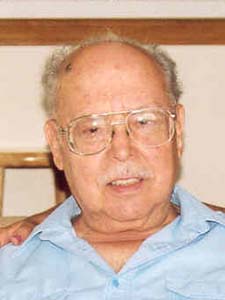Moises Garcia Munoz (1922-2004)
MOISES GARCIA MUNOZ, 82
Retired U. of C. astrophysicist
By Imran Vittachi
Tribune staff reporter
Published October 2, 2004
 Moises
Garcia Munoz hated being called "doctor."
Moises
Garcia Munoz hated being called "doctor."
The astrophysicist with a Ph.D. was not one to flaunt his high-level intelligence and learning, or his achievements in the lab. He would cringe even if "Dr." appeared next to his name on a dinner reservation, said his daughter, Veronica. "If you met him, you'd never guess he was a scientist," she said, alluding to her father's disdain for fussing about his clothes and appearance. "But once people talked to him and realized who he was, they would be in awe."
Mr. Garcia Munoz instead devoted his time to researching nuclear particles in outer space. His studies into cosmic rays--shafts of nuclear radiation that shoot through the galaxy as stars explode--contributed to a better understanding of how they function and propagate through interstellar space, said Bruce McKibben, a former colleague at the University of Chicago.
Mr. Garcia Munoz's work was important, McKibben said, because of the of its practical-application aspect. Cosmic rays have impeded plans for sending a manned mission to Mars because their nuclear radiation could endanger astronauts, who are exposed to them for extended periods of time, such as long-duration or deep-space flights, McKibben said.Mr. Garcia Munoz, an astrophysicist at the U. of C.'s Fermi Institute who was among the pioneers of scientific research into cosmic rays, died Monday, Sept. 13, in his home in Orland Park of complications from a stroke. He was 82.
Born in Valencia, Spain, into a family of modest means, Mr. Garcia Munoz strove to get good grades. He succeeded and was admitted into the Polytechnic Institute in Zurich.
In 1957, Mr. Garcia Munoz received his doctorate in physics from the University of Madrid. He became a researcher at the Junta Nuclear, an institute established by the Franco regime for studies into the uses of nuclear energy.
But he was too disgusted with the regime to stay in Spain much longer. Mr. Garcia Munoz felt that the Junta's culture of scientific research became corrupted under the dictatorship.
In 1959 Mr. Garcia Munoz left Spain and arrived in Chicago, where he joined the scientific staff at the Fermi Institute. Under Prof. Samuel Allison, the 37-year-old scientist began exploring problems in experimental atomic physics.
In 1968 Mr. Garcia Munoz changed research areas. He moved to the institute's Laboratory for Astrophysics and Space Research, where he joined a study group headed by another eminent U. of C. scientist, professor John Simpson.
Until his retirement in 1995, Mr. Garcia Munoz's research centered on the physics of cosmic rays.
Over 27 years, Mr. Garcia Munoz made several major contributions to the study of cosmic rays, McKibben said. These included the first comprehensive study into the nuclear makeup of cosmic rays, and the first measurements of the isotopic composition of nuclei in cosmic rays ranging from lithium to neon.
Mr. Garcia Munoz also collaborated with Simpson on at least seven Earth-orbiting satellite missions and one into deep space, McKibben said.
The two scientists designed and tested cosmic ray-measuring instruments, with which they gathered and analyzed data.
Through his measurements of the radioactive isotope of beryllium, Mr. Garcia Munoz became the first astrophysicist to estimate the average age of cosmic rays--20 million years--McKibben noted.
Other survivors include his wife, Jacquie; a sister, Gloria; and a brother, Tomas. Services have been held.
Back to Home